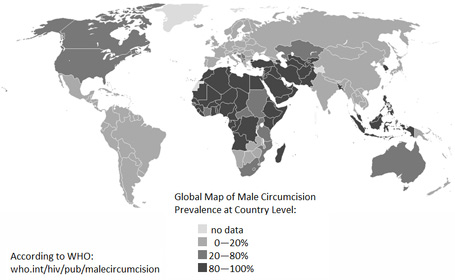The foreskin, for those of you who don't have one (or, worse, have never seen or tasted one), is a retractable double-layered fold of skin and mucous membrane that covers the glans penis and covers the mouth of the urinary tract when the penis is not erect. This is supposed to protect the urinary tract, but there has been some evidence that infections of the penile glans and urinary tract are more common in uncicrumcised men than in their circumcised brothers. Indeed, the most-often quoted reason for circumcision is for both cultural/religious and for hygienic reasons. All Jews and Muslims and some groups of Christians cirumcise their boys, often following quite detailed rituals. For a map of circumcision rates in the world, see [1] - very helpful in determining your favorite circumcised holiday destination.

Circumcision can be done using several different techniques. I looked it up on Wikipedia [2] and copied some of the below from there. It is not for the faint-hearted! For infant circumcision, devices such as the Gomco clamp, Plastibell, and Mogen clamp are commonly used. With all these devices the same basic procedure is followed. First, the amount of foreskin to be removed is estimated. The foreskin is then opened via the preputial orifice to reveal the glans underneath and ensure it is normal. The inner lining of the foreskin is then bluntly separated from its attachment to the glans. The device is then placed (this sometimes requires a dorsal slit) and remains there until blood flow has stopped. Finally, the foreskin is amputated. Sometimes, the frenulum band may need to be broken or crushed and cut from the glans penis near the urethra to ensure that the glans can be freely and completely exposed. If this is not done early, the frenulum may come off the glans when intercourse is started, leaving a bloody mess.
People who oppose circumcision find it unnatural to remove a part of the body that was created by Nature, or by God, or both. Some people find the practice unfair to small children who can not make decisions about their own body.
Proponents counter that Jesus himself was circumcised. As a result, several churches have claimed at times to be in the possession of the foreskin of Jesus Christ, ascribing miraculous powers to 'the Holy Prepuce'. While it is strictly beyond the point of this column, if you happen to find it somewhere, let me know.
Opponents of circumcision claim the foreskin has a function during sex. It contains nerve ends that are highly erogenous, and tend to stimulate sexual arousal upon stimulation. They argue that the gliding movement of the foreskin during intercourse is important in creating pleasure for both parties, and that it reduces friction and helps to lubricate the vagina or anus. It may also make masturbation easier, as less strain might be needed to be exerted to the penis in order to get an orgasm. Other scientists refute this, saying there is no evidence that circumcised men have less fun than uncircumcised men.
What does the foreskin have to do with HIV transmission? The foreskin contains a certain type of cells called 'Langerhans Cells' (named after Paul Langerhans, the guy who discovered them back in 1868). These cells form an entry-point for HIV virions into the body, and can also be a reservoir for HIV infection once it has established itself. In addition, during heavy sex sessions, the foreskin might tear and cause bleeding, further enhancing the possibility of transmission of HIV or other diseases. Third, several sexually transmitted diseases appear to really like foreskins much better than bare willies. These diseases have been shown to help in the transmission of HIV.
The website of the US CDC [3] summarises a systematic review and meta-analysis that focuses on male circumcision and heterosexual transmission of HIV in Africa[4]. A substantial protective effect of male circumcision on risk for HIV infection was noted, along with a reduced risk for genital ulcer disease. After adjustment for confounding factors in the population-based studies, the relative risk for HIV infection was 44% lower in circumcised men. The strongest association was seen in men at high risk, such as patients at sexually transmitted disease (STD) clinics, for whom the adjusted relative risk was 71% lower for circumcised men.
A 71% lower risk for high risk men! No wonder that circumcision fans welcomed this new technology for HIV prevention. Circumcise men at risk for HIV and stop the epidemic without bothering about condoms! No need to add that there was a lot of politics involved too. People who routinely circumcise their boys were all for this new technology, whereas those who do not circumcise their boys balked at the idea.
So does this technology work for us, gay men? Is there a protective effect of circumcision during anal sex, or only in vaginal intercourse? Do we all have to line up at the circumcision clinics, and say goodbye to our Holy Prepuce?

The answer is, fortunately for those who love their foreskins, a resounding NO. The difference of gay men and heterosexual men is that gay men often have sex both ways - i.e. they use their penises to fuck, and use their anuses to be fucked. The main avenue for HIV transmission for gay men remains our beloved rectum, which is so convenient to sit on, but which is in other circumstances highly conducive for all kinds of pleasant and unpleasant organisms. The heterosexual men in the studies in Africa had only one clear entry-point for HIV - which was their foreskin. Removing that reduced their chances of infection. It did, of course, not reduce the chance of infection from them to their female partners. On the contrary - there were some reports of men starting sex too soon after their recent circumcision, with bleeding as a result; this, if anything, would increase the chance to get HIV for their female partners.
A recent review study showed that circumcision did not protect gay men from infection with HIV, overall [5]. However, circumcision may protect gay men who are exclusively insertive for anal sex from infection with HIV, the review as well as a recent Australian study suggest [6]. But this finding is based on sketchy evidence. The investigators comment: “Being circumcised was associated with a significant reduction in HIV incidence among the one-third of participants who reported a preference for the insertive role in anal intercourse”. However the numbers were very small – a larger study would be needed to see if this is important.
So should you get circumcised?
The American CDC says on its website that individual men may wish to consider circumcision as an additional HIV prevention measure, but they must recognise that circumcision 1) does carry risks and costs that must be considered in addition to potential benefits; 2) has only proven effective in reducing the risk of infection through insertive vaginal sex; and 3) confers only partial protection and should be considered only in conjunction with other proven prevention measures (abstinence, mutual monogamy, reduced number of sex partners, and correct and consistent condom use).
If you want to do it, you may like to know that adult circumcisions require 4 to 6 weeks of abstinence from masturbation or intercourse after the operation to allow the wound to heal. Also, there are several techniques for circumcision, removing a larger or smaller part of the foreskin and making a different ‘cut’ which leads to different forms and shapes of the resulting scar - with highly different aesthetic results. You can have influence on the location and the shape of the scarline, eg. just below the corona or futher down the shaft of the penis. Make sure you check out the market, and don't fall for the first guy in a white coat and a nice smile, wielding his scissors.
Nice to know: after hospital circumcision, the foreskin may be used in biomedical research, skin grafts or consumer skin-care products. Think about that when you apply that night cream before going to bed. Conclusion: current evidence suggests that circumcision is NOT an effective HIV prevention strategy for gay men. It may be at the individual level, but only if you are a) HIV negative, b) only insertive, c) REALLY only insertive, d) never lie about your sexual behavior, and e) always, always keep your rectum shut for intruding unidentified hard objects. And even then, the protective effect of circumcision remains doubtful.
Links:
1. Global Map of Male Circumcision Prevalence at Country Level
2. http://en.wikipedia.org/wiki/Circumcision
3. http://www.cdc.gov/hiv/resources/factsheets/circumcision.htm#ref5
4. Weiss HA, Quigley MA, Hayes RJ. Male circumcision and risk of HIV infection in sub- Saharan Africa: a systematic review and metaanalysis. AIDS. 2000 Oct 20;14(15):2361-70.
5. Templeton DJ, Millett GA, Grulich AE. Male circumcision to reduce the risk of HIV and sexually transmitted infections among men who have sex with men. Curr Opin Infect Dis 2010, 23:45-52
6. Templeton DJ et al. Circumcision and risk of HIV infection in Australian homosexual men. AIDS 23: 2347-51, 2009.
Jan Wijngaarden has worked, in different functions and roles, on promoting HIV prevention, care and support for men who have sex with men (MSM) since 1994. He is also the moderator of MSM-Asia, an information network on MSM, HIV and human rights, with nearly 600 members from across the region. If you want to become a member of MSM-Asia, or for information requests or comments, pls contact him at jwdlvw@gmail.com.
